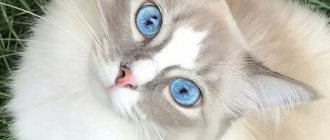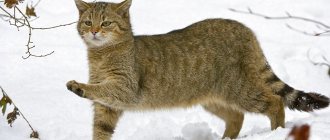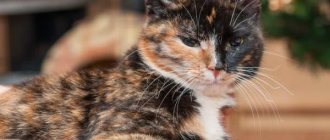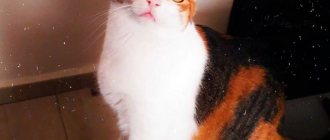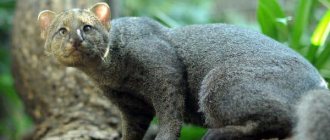History of the discovery of the species
A small inhabitant of the highlands of Latin America was first described by a scientist from Italy, Emilio Cornalli, in the middle of the nineteenth century.
This animal is so secretive that even today there are simply no reliable facts about its way of life.
In 1865, scientists also demanded unconditional facts proving the existence of a mysterious animal, but apart from the skins of animals that occasionally appeared in Indian markets, there was nothing to present to the world community.
It was only in the 90s of the last century that photographs of Andean cats appeared, and at the end of the century the elusive animal was tracked down by researcher and naturalist Jim Sanderson on the border of Peru and Chile. The scientist was able to approach the predator at arm's length and take a series of photographs. At the same time, the Andean cat completely ignored the person and did not show any signs of aggression.
A pair of Andean mountain cats was found at the beginning of this century in the Argentine reserve Caverna de Las Brajas.
Moreover, one of the specimens was a female with cubs, hiding in a small cave high in the mountains. The reserve employee even managed to take a few photographs.
In 2004, in a national park in Bolivia, one such cat was even captured and radio-collared. Observations were carried out for no more than a year, were very meager and only made it possible to confirm the nocturnal lifestyle of the small predator. Soon the individual died in a poacher's trap.
All researchers note that it is impossible to see the same animal twice. The distrustful and secretive animal immediately changes its location after the slightest contact with a person.
Nevertheless, the description made by an Italian scientist in 1865 is fully confirmed based on accumulated facts.
According to the testimony of South American Indians, earlier populations of these animals were more numerous, but cats were simply stoned to death as soon as they approached human camps.
For some reason, killing this animal was considered the greatest achievement. No one has ever managed to tame the distrustful predator. The Indians reported that in captivity the Andean cat is not able to live even a year, it refuses food and water, and simply dies.
Apparently, this attitude of people has developed in the predator a stable habit of carefully hiding, as well as migrating to the most inaccessible mountainous areas.
Most likely, the population of Andean mountain cats is the smallest on Earth and barely amounts to two and a half thousand individuals.
Mr. Cat recommends: characteristics, habitat
The Andean mountain cat (Leopardus jacobitus) is a small, high-altitude wild cat that is now listed as critically endangered on the IUCN Red List because there are fewer than 2,500 specimens of the creatures alive in the world, scientists believe. , still exist in the wild.
The species was first described by Emilio Cornalli, who named it after the Jacobite Mantegazza.
The Andean mountain cat has ash-gray fur, a darker shade of the head, ears and muzzle. The areas around the lips and cheeks are white, with two dark brown lines running from the corners of the eyes through the cheekbones. There are several black spots on the front legs, yellowish-brown markings on the sides, and up to two narrow dark rings on the hind legs. The long, bushy tail has 6 to 9 rings, ranging from dark brown to black.
The markings of the young are darker and less pronounced than those of sexually mature individuals. The skulls of adults range from 100.4 to 114.8 mm or more in length, and are somewhat larger than those of Pampas and domestic cats.
The Andean mountain cat has a black nose, lips and rounded ears. On the back and tail the hair is 40-45 mm long. Its rounded toes are 4 cm long and 3.5 cm wide. The paw pads are covered with hard hairs, which allows it to move on hot rocks in summer or cold rocks in winter.
The size of adult individuals varies from 57.7 to 85 cm in length from head to rump, long tail from 41.3 to 48.5 cm. Height at the withers is about 36 cm, and body weight is up to 5.5 kg.
The South American mountain cat lives only at high altitudes in the Andes. Camera footage from observers in Argentina, only made public in 2000, shows it ranges in altitude from 1,800 m above sea level in the southern Andes to over 4,000 m in Chile, Bolivia and central Peru.
The area is extremely arid, with sparse vegetation, rocky and steep. The Andean cat population of the Salar de Surire Nature Reserve was estimated at five individuals in an area of 250 square meters. km.
A survey of observers and local people in the province of Jujuy in northwestern Argentina indicates densities of 7 to 12 individuals per 100 square meters. km. at an altitude of about 4200 m above sea level.
Andean mountain cats are found locally. Their Andean habitat is fragmented by deep valleys.
Scientists in some scientific classifications classify the Andean cat as a separate genus Oreailurus, but official ones still classify it as a tiger Leopardus, which also includes their closest relative Ocelot.
Domestic cat breeds with big ears
Many pets have wonderful and large ears. Their most prominent representatives.
Siamese cats
This ancient breed of pets is characterized by a triangular muzzle with an oriental cut of bright blue eyes and large, pointed, wide and oblique ears. The characteristic color is color-point in various colors.
Those with a noisy and restless temperament are strongly attached to their owner and are very talkative.
Widely distributed and affordable. In Russia, a pet-class kitten can be bought for five thousand rubles; purebred animals are much more expensive - up to sixty thousand.
Read more in the article about Siamese cats.
Balinese or Balinese cat
This is a semi-long-haired version of the Siamese. Similar to its relative in appearance, character and price of a kitten.
We wrote more in the article about the Balinese.
Abyssinian cat
This naturally formed breed was known back in Ancient Egypt. They bear the name of ancient Ethiopia (Abyssinia).
Wild, Sorel, Blue and Fawn are the main colors of the uniform ticked short coat. The remarkable large, widely spaced ears, according to some sources, previously ended in a tassel.
In character they are more reminiscent of a restless monkey. Widespread, you can buy a kitten for a price from ten to fifty thousand rubles.
Also read about Abyssinian cats and their long-haired variant, Somalia.
Somalia
This is an amazing long-haired variety of the Abyssinian. In character and appearance it is practically no different from its relative. The price for such a kitten is slightly lower.
Orientals
These cats do not conquer everyone with their appearance and character. But the huge ears leave no one indifferent.
The breed was bred from the Siamese. This sophisticated athlete with short hair without undercoat, a triangular head with huge ears protruding from the sides, resembles a bat or a space alien.
They do not tolerate cold well and are quite capricious in their care. The cost of a kitten is about twenty to sixty thousand rubles, depending on the class of the animal.
Read more in the article about the Oriental cat.
Cornish Rex and Devon Rex
A variety of breeds with short curly hair, huge eyes and prominent ears set low on the sides of the head. Nose with a break.
Cornish Rex
Devon Rex
They are very attached to people, kind and playful. You can buy a kitten for a price ranging from fifteen to fifty thousand rubles.
Sphinxes
A large group of hairless cats, including Canadian, Don and Petersburg (Peterbald) Sphynxes. Read the article about all types of the Sphinx breed.
Canadian Sphynx
The Canadian is the earliest breed, over fifty years old. With minimal differences, all these animals are characterized by a warm, pleasant to the touch velvety body with many folds on the skin. They are almost always completely hairless.
Don Sphynx
The head is large in relation to the body with almond-shaped eyes and prominent ears.
Peterbald
Prices for kittens depend on many factors and lie in a very wide range from ten to seventy thousand rubles.
Elf
Also applies to hairless breeds. Obtained by crossing the American Curl and the Canadian Sphynx. Possessing the characteristic features of the latter, including large expressive ears.
A rare and expensive animal worth from one to five thousand dollars, depending on the class of the kitten.
Read more in the article about Elves.
Ukrainian Levkoy
This hairless cat gets its name from its oddly shaped ears—large, soft, and folded forward at the tips. But there are also straight-eared individuals.
The price for a kitten is about twenty thousand rubles.
You can learn more from the article about Ukrainian Levkoys.
Maine Coon
A natural, very large, long-haired hybrid with large ears ending in a tassel - a lynx-like animal. There is a legend that they originated from the wild North American lynx.
Quite calm animals with a bunch of severe hereditary diseases. Despite this, they are very popular. The cost of the animal is from thirty to seventy thousand rubles.
More interesting information about Maine Coons on the Mister Cat portal.
Turkish Angora
It is surprising that these long-haired snow-white beauties with angelic blue or multi-colored eyes have very large ears and are not from the East. Very popular, widespread, affordable price - from ten thousand rubles.
Read more in the article about Turkish Angoras.
Kanaani or Canaani
People from the biblical area of Canaan. The breed is experimental, leopard color and wild type. The excretion contains the blood of wild and domestic cats. The breed is very young and quite expensive due to its rarity. Prices start from thousands of euros.
Serengeti
Outwardly they are somewhat reminiscent of Savannah, but much smaller. This is not a hybrid, obtained through selection of various domestic breeds. The ears are very similar to the Serval shells. Price from thirty thousand rubles.
Read more in the article about the Serengeti.
Poodlecat
An amazing breed bred in Germany with long wavy hair. Obtained by natural mutation of natural genes. Long ears can be straight or curved - hanging. Few in number and little known, these animals do not exist in Russia.
Toyger
This breed has gone quite far from its ancestor - the Bengal. But it is still more correct to classify it as a hybrid animal. Usually much larger than the Bengal, instead of the leopard color it has brindle - there are bright black stripes on the body. The price of a kitten is from forty to one hundred thousand rubles.
Read the article about Toygers.
Morphological differences between Andean and Pampas cats
The Andean mountain cat and the Pampas cat look almost identical. This makes it difficult to determine which animal is being observed and makes it difficult to properly estimate populations.
Pampas cat
This can be confusing when trying to get the correct information from observations of naturalists who have seen one of these cats but do not realize that they need to look for specific features to differentiate between the two species.
The characteristics of both types of small cats are shown in the table:
| Andean mountain cat | Features | Pampas cat |
| Two thirds of the total body length. Thick and blunt at the tip with 6-9 wide rings. | Tail | Half of the total body length. Thin and pointed at the tip, with 9 thin rings. |
| The maximum width of the ring marks is about 6 cm. | Ring markings on tail | The maximum width of the rings is 2 cm. |
| Characteristic lines on the sides of the eyes. Rounded ear tips. | Description of the muzzle | If stripes are present, they are brown and less pronounced. Triangular-tipped ears are characteristic of most representatives of this species. |
| Very dark or black. | Nose | Light, usually with pink lobe. |
| Yellowish, rusty or grayish and charcoal shades. | Color | Beige, cream, reddish, rust and anthracite colors. |
| One consistent pattern type. | Markings | Three different fur patterns with different variations. |
| Uniform coloring of the main color. | Ear color | Patterned colored ears. |
| The rings are not completely closed, the stripes look like spots. | Front paw coloring | Two or more clear, full, black rings. |
Description of the rusty cat
The rusty spotted cat has short, soft, light gray fur with a beautiful reddish tint. Its body is covered with lines of small rusty-brown spots, which condense to form continuous stripes along the back of the head, sides and rear surface of the body. The underside of the body is white, decorated with large spots and stripes of a different shade. The muzzle is decorated with two dark stripes located on the cheeks of the animal. They extend straight from the eyes to the shoulders, avoiding the area between the ears. The head of a rusty cat is small, round, slightly flattened with an elongated muzzle. The ears are small and round, set wide apart relative to the skull. The tail is decorated with faint dark rings.
Appearance
The fur of reddish-spotted cats is short and brownish-gray in color with a rusty tint. The coat of the Sri Lankan cat subspecies has fewer gray tones in color, leaning more towards reddish tones. The ventral side and neck of the animal are white with dark stripes and spots. The back and sides are dotted with rusty-brown spots. Four darkish stripes, as if imposingly, descend from the cat’s eyes, pass between the ears to the shoulder area. The soles of the feet are black, and the tail is approximately half the length of the head and body combined.
The rusty cat is on average half the size of a regular domestic cat. Mature females can weigh up to 1.4 kg, and adult males up to 1.7 kg. It is interesting that at the first stages of development, namely up to the age of 100 days, females are larger than males. After this milestone, the situation changes to superior male size. Males are also usually heavier.
Lifestyle, behavior
This incredibly agile reddish-spotted animal appears to be primarily nocturnal, spending its days inside a hollow log or forest thicket. Despite its wonderful climbing abilities, the rusty cat hunts on the ground, using the skill of climbing trees in its free time from hunting or for retreat.
Rusty spotted cats are solitary animals that live in forests. Although recently they can be increasingly found in agricultural areas where humans dominate. The species is considered terrestrial, but has distinct arboreal tendencies. When these cats were first brought to Frankfurt Zoo, they were initially considered to be nocturnal animals because most sightings were recorded at night, early morning at dawn or late evening. Based on this principle, they were identified in the zoo as nocturnal inhabitants. However, it soon became clear that they could not be strictly nocturnal or diurnal animals. Sexually active cats were more active during the daytime.
This is interesting! The principle of communication and connections between representatives of the species is based on smell. Both female and male rusty cats mark territory by spraying urine for scent marking.
How long do rusty cats live?
The longest lifespan of a rusty spotted cat was recorded at the Frankfurt Zoo, thanks to a cat who reached the age of 18 years.
Sexual dimorphism
Sexual dimorphism is not clearly expressed. Up to 100 days from the moment of birth, the female looks larger than the male, which gradually changes as the animal ages. In adults, the male is heavier than the female.
Return to content
Features of behavior
The usual climatic conditions for Andean cats are rocks, high mountain ranges, steep mountain slopes, dry, cold or too hot air, low rainfall.
The environment has made this predator a creature with a high degree of survival in conditions of hot summers and very cold winters, an almost complete absence of flora and water sources. Although outwardly the Andean cat is not very different from its domestic relatives, it is an extremely hardy animal that can safely enter into battle with an enemy superior in strength and size.
This is an extremely dexterous and maneuverable creature that moves without fear along almost vertical rocks, is not afraid of enormous heights, easily overcomes any obstacles, performing incredible somersaults and jumps in the air, changing the direction of movement right in flight.
The Andean cat has a perfect hearing aid that allows it to detect the slightest rustles of potential prey and enemies.
The animal's vision and sense of smell are also excellent. In behavioral reactions, this animal is similar to its Pampas counterpart, with which it periodically intersects in its native habitat.
This is a characteristic nocturnal solitary predator that mates only during the mating season.
Recent research by scientists suggests that the hunting grounds of each Andean predator occupy from 35 to 70 square meters. km. Their border is marked by physiological secretions and scrapes, which are periodically renewed. At the same time, the territories of male and female individuals, unlike representatives of other cat species, do not overlap.
The animal practically blends in color with the mountain landscape due to its grayish color, so it is very difficult to detect.
An excellent balancer – a long and thick tail – helps the animal change the direction of its jump in the air. Thick and dense fur perfectly protects the cat from the harsh winter.
The animal is content with a small amount of moisture, which it obtains mostly from melted mountain springs and from living food.
Read: 47 representatives of the cat family and their photos.
Diet
Mountain Andean cats are secretive and cautious hunters; there is only speculative information about their diet. Most likely, this is an extremely poor choice due to the small amount of potential prey in the animal’s natural habitats:
- The mountain spotted viscacha is a large rodent, weighing up to three kilograms, resembling a rabbit in appearance.
- The chinchilla is a crepuscular rodent that lives in colonies.
The Andes Mountains are home to six different species of predators, three of them being cats, the Andean cat, the Pampas cat and the puma.
Of these, the puma is a large predator, and the Andean cat and the Pampas cat are medium-sized predators and are very similar. They both hunt in the same territory and the same prey due to the low genetic diversity of the area.
Vizcacha accounts for 93.9% of the biomass consumed in the Andean cat's diet. This is due to the fact that there are significantly fewer other prey objects, in addition, these rodents also lead a crepuscular lifestyle. And the Pampas cat depends on Vizcacha by 74.8%.
In some areas, the mountainous Vizcach will account for 53% of the Andean cat's production.
By the way, researchers believe that in those areas where there are few colonies of viscachas and chinchillas, Andean cats can hunt during daylight hours.
Puberty and reproduction
Thanks to observations by residents of the Andean mountains of cats paired with the opposite sex and with kittens, it can theoretically be assumed that the predator's mating season lasts from July to August. Since kittens were spotted in April and October, it is believed that the mating season may extend into November or even December.
A litter usually consists of one or two kittens born during the spring and summer months. This is typical for many other cat species, which also give birth to young during periods when food supplies are sufficient.
Puberty, as scientists suggest, occurs in animals closer to two years, and the average life expectancy does not exceed ten years.
Features of mating Chinese Li Hua cats
Mating is carried out on the territory of the male. In order for the cat to quickly adapt to a new place, it is brought along with personal belongings. After mating, the cat’s interest in the female disappears, as the specific smell ceases to emanate from her.
Bombay cat - description of Bombay cats
Pregnancy lasts about 10 weeks. Childbirth is easy, often in a litter of 3-4 kittens.
Important! To keep a Chinese cat healthy, it is not recommended to cross it more than once a year.
Keeping the Andean cat in captivity
This rarest animal in the world is not kept in any zoo in the world.
Besides the fact that the Andean mountain cat is extremely difficult to catch, it simply does not survive in captivity.
Information about the residence of these cats in nature reserves and national parks of South America is extremely rare.
This animal is strictly protected, so its illegal resale is punishable by law in the same way as hunting it or trading in skins and any other body parts.
Modern classification of wild cats
Once upon a time, all cats were divided into three subgroups. Nowadays, zoologists divide wild cat families into large and small cats. Previously, the cheetah subfamily was distinguished, but then, as a result of a study of the DNA of these animals, it was determined that they are close to small cats. Each subfamily contains several genera, which differ in habitat, size, color, and habits.
Subfamily of small cats
This group of mammals is divided into 12 genera and almost 30 different species. A distinctive feature of representatives of this subfamily is the ability to rumble when inhaling and exhaling. Representatives of some species can reach two meters in length.
Small cats have enviable eyesight, excellent hearing and a good sense of smell. These predators feed on small mammals, such as rodents, and birds.
Cheetah and caracal
Cheetahs are the fastest cats in the world: they can reach speeds of up to 120 km/h. True, an animal can run so fast for only a couple of minutes. This type of cat has a long body - about 140 cm. The color is sandy with characteristic spots.
Caracal
Caracal, or, as it is also called, steppe lynx. The body length of this animal can reach up to 82 cm. Distinctive features of the caracal are the presence of tassels on the ears, as well as hair brushes on the paws. It is very agile and can jump deftly.
Population protection
In 2002, the Andean cat's status was upgraded from Vulnerable to Endangered on the IUCN Red List of Threatened Species.
As the habitat spread across four countries, biologists attempted to collaborate in efforts to protect the species. One of the groups formed was the Committee for the Conservation of Andean Cats, now known as the Andean Cat Union.
The direct threat to these predators is loss of habitat, and the indirect threat is various forms of land use, including mining and water extraction, which could potentially increase as a result of climate change.
Also dangerous are inappropriate pastoral and agricultural practices, unregulated tourism, secondary mineral and water extraction, and oil and gas extraction.
A separate point in preserving the species is in resolving conflicts with small livestock farming, in the fight against insufficient knowledge of the species by members of the local community, protection from dogs, accidental exposure to traps.
Scientists paid special attention to the fight against the religious use of Andean cat skins and taxidermy, hunting animals according to traditional beliefs and superstitions.
The Andean cat's habitat spans four different countries in South America. Each has enacted individual laws to protect this endangered animal.
Each country also has its own protected areas where hunting any animals is completely prohibited.
Naturalist Jim Sanderson is still concerned about the fate of the Andean cat.
Through his efforts, together with Constanza Napolitano, Lilian Villalba, Eliseo Delgado and other researchers, a conservation agreement was concluded between the Andean Cat Union and the non-profit organization Fundación Biodiversitas and the government agency CONAF, responsible for the management of national parks and industrial forests.
Villalba of the Andean Cat Union conducted a major research program, including radio telemetry studies, in the Jastor region of southern Bolivia between 2001 and 2006.
Interesting facts about the Andean cat
The Andean mountain cat is the rarest and least studied animal in Latin America, despite the fact that it has been known to people for a very long time.
One of scientists’ versions of the degeneration of the species is a sharp decline in the populations of mountain chinchillas.
The local population of Chile and Peru has been trying to catch the Andean cat for many years, but almost no attempt has been successful.
Due to the impossibility of keeping the Andean cat in captivity, there is no possibility of creating hybrid species or artificially increasing the population size.
Population and species status
The Indian cat population is listed on Appendix I of the Convention on International Trade in Endangered Species (CITES). This means that trade in individuals from the Sri Lankan population is only permitted in exceptional circumstances and must be carefully controlled to ensure that it is compatible with the survival of the species. The rusty-spotted cat is legally protected throughout most of its range and is prohibited from hunting.
According to the IUCN Red List, the total population of rusty cats in India and Sri Lanka is less than 10,000 adults. The downward trend in their numbers is due to habitat loss, characterized by deterioration of the natural forest environment and an increase in the area of agricultural land.
Return to content
